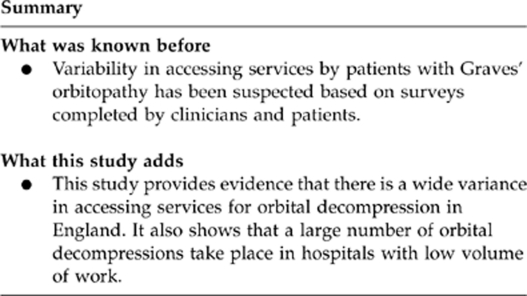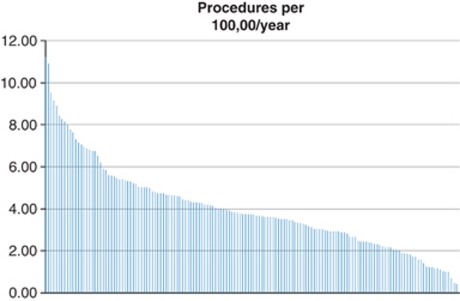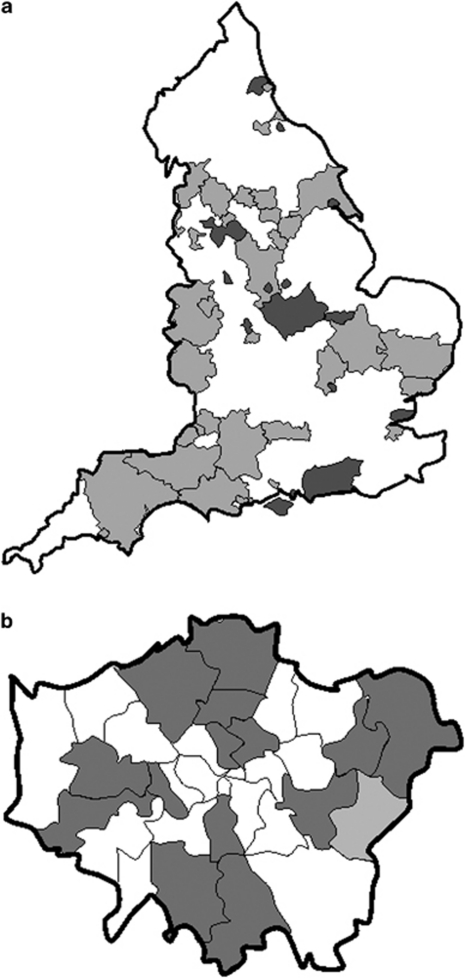Abstract
Aims
The purpose of this study was to obtain data on orbital decompression procedures performed in England, classed by hospital and locality, to evaluate regional variation in care.
Methods
Data on orbital decompression taking place in England over a 2-year period between 2007 and 2009 were derived from CHKS Ltd and analysed by the hospital and primary care trust.
Results and conclusions
In all, 44% of these operations took place in hospitals with an annual workload of 10 or fewer procedures. Analysis of the same data by primary care trust suggests an almost 30-fold variance in the rates of decompression performed per unit population. Expertise available to patients with Graves' orbitopathy and rates of referral for specialist care in England appears to vary significantly by geographic location. These data, along with other outcome measures, will provide a baseline by which progress can be judged.
Keywords: Graves, orbitopathy, ophthalmopathy, thyroid, decompression
Introduction
Graves' orbitopathy is a disease that attracts relatively little attention from health strategists, as it is perceived to be a low priority when compared with conditions like cancer, stroke, or diabetes. Yet, Graves' orbitopathy affects approximately 0.25 million people in England and is associated with a significant psychological and socioeconomic burden.1, 2, 3 Surveys of health-care professionals and of patients have illustrated that Graves' orbitopathy is often treated inadequately and in centres with little experience.4, 5, 6, 7 The Amsterdam Declaration is a recent incentive supported by many national and international professional and patient-led organizations, aiming to improve the outcomes of patients with Graves' orbitopathy.8 TEAMeD UK (Thyroid Eye disease Amsterdam Declaration Implementation Group UK) is a recently established multidisciplinary group with representatives from the Royal College of Physicians, Royal College of Ophthalmologists, Society for Endocrinology, British Oculoplastic Surgical Society, Scottish Ophthalmological Club, British Thyroid Association, British Thyroid Foundation, and Thyroid Eye Disease Charitable Trust. TEAMeD's remit is to implement the objectives of the Amsterdam Declaration in England. This report provides baseline data against which improvement in the management of patients with Graves' orbitopathy might be compared in the future.
The targets of the Amsterdam Declaration include greater access of patients to centres of excellence. Surgical decompression of the orbit, performed almost exclusively in patients with Graves' orbitopathy, is a specialist procedure that requires a sufficient volume of work to establish and maintain surgical skills. The most common indication for surgical decompression in patients with Graves' orbitopathy is to improve appearance with visual failure being the second;9, 10 hence, this procedure is usually offered to patients with severe disease. The threshold at which clinicians offer this procedure for non-sight-threatening reasons is partly determined by their experience and available expertise, but may also be influenced by institutional complication rates.
The purpose of this study was to obtain data on orbital decompression procedures performed in England, classed by hospital and locality, as a surrogate marker of local expertise available to patients as well as an indicator of regional variation in referral rates for specialist care.
Materials and methods
Data on orbital decompression in England for 2 years (between January 2007 and January 2009) were obtained from CHKS Ltd, a Capita Group company (http://www.chks.co.uk/). The figures were collected on the basis of Health Resource Group coding for orbital decompression (CO63) and were analysed by the hospital and primary care trust. For analysis by geographical area, the National Health Service document, the ‘Primary Care Trust Configurations', was used (http://www.ehiprimarycare.com/img/document_library0282/pct_configurations.pdf). Descriptive statistics, the Mann–Whitney U-test, and ANOVA were used for analysis.
Results
In all, 502 procedures with the coding for orbital decompression were registered during the study period, and 281/502 procedures (56%) were carried out in eight hospital trusts that performed more than 10 procedures per annum; 104/502 procedures (21%) took place in eight hospital trusts that performed 5–8 procedures per year and the remaining 117 (23%) procedures were carried out in hospitals logging fewer than 5 such procedures annually.
The same data were analysed by the primary care trust, each primary care trust representing a well-defined geographical area within England: 151 primary care trusts, serving a population of over 50 million, funded operations coded as CO63 during the study period. The median annual number of operations per 100 000 population was 3.7, the range being from 0.4 to 11.3 (Figures 1 and 2); there was no correlation between the population size of a primary care trust and the annual number of operations per 100 000 population. To further explore the effect of geography on the rate of orbital decompression in different hospitals, we hypothesised that—provided access to centres offering decompression was unrelated to distance—the rate of decompression per unit population should be the same for patients residing within 20 miles of such units, as compared with those residing outside this zone. A comparison of such groups of patients for the five major centres providing decompression (Table 1) shows, however, that patients living further away were significantly less likely to undergo a decompression than patients from the primary care trusts closer to those centres (P<0.001).
Figure 1.
Decompression procedures by primary care trusts (PCTs). Rates of decompression per 100 000 population per annum (vertical axis) by different PCT in England.
Figure 2.
Map of England showing decompression procedures by primary care trust (PCT): (a) English PCTs excluding London and (b) London PCTs. PCTs with the highest quartile decompression rates are shown in dark grey. PCTs with the lowest quartile decompression rates are shown in light grey.
Table 1. Rates of orbital decompression by PCT considered in relation to their proximity to major centres.
| Area | Population | Decompressions per 100 000/annum (median, range) |
|---|---|---|
| PCTs within 20 miles of five English hospitals with the highest annual decompression rates | 24 489 308 | 4.35 (0.47–11.3)* |
| PCTs in the rest of England | 26 215 681 | 2.93 (0.39-8.4)* |
Abbreviation: PCT, primary care trust.
*P<0.001.
Discussion
Graves' orbitopathy is a rare disease of autoimmune aetiology,11 and treatment is often lengthy, can require multiple modalities, and is best delivered in specialist centres.12 Orbital decompression can restore appearance and save vision, leading to major improvements in quality of life.9 The data presented here provide an insight into the current management of patients with Graves' orbitopathy in England. To our knowledge, this is the first geographically based study of orbital decompression. A strength of this study is its large population base (50 million).
The most striking finding was that most hospitals offering orbital decompression actually performed very few such procedures each year. Moreover, the number of such procedures funded by the primary care trusts varied 30-fold, this appearing to show a vast geographical difference in the referral rates of patients to specialist centres. In all, 21 PCTs (14%) serving a population of 7.7 million people funded fewer than two decompression procedures per 100 000 population per annum.
The patients relevant to this study represent the more severe spectrum of Graves' orbitopathy, but similar issues about variability of care have been highlighted in all patients with Graves' orbitopathy.7 The data were generated by coders and concerns about the accuracy of such information have been voiced.13, 14 However, Health Resource Group data are increasingly considered appropriate for use in health-care research.15, 16 Although it was not possible for the authors to validate all the data, the authors are directly involved in services in four major centres and found that the figures for their own centres generated by CHKS Ltd appeared to be appropriate. The use of routinely collected statistics has the weakness that the data are less detailed (eg, lack of information on indications for orbital decompression), but an important advantage is that it is comprehensive. The alternative methodology (questionnaire studies to individuals centres) has a high likelihood of low response rates4 and bias towards ‘enthusiasts', which may be high volume centres. Since exploring regional variation between centres and PCTs was the main aim of this study, it was considered that the use of routinely collected data from all regions was the more appropriate methodology.
It is generally accepted that specialist procedures should be conducted in centres where they are performed regularly, as this improves the outcome and reduces the rate of complications.17, 18, 19, 20 Translating this to an annual minimum desirable number of operations per centre is difficult, controversial, and depends upon the procedure. Realistically, surgeons performing fewer than five decompressions annually would probably struggle to maintain the necessary skills, and many would argue that the minimum should be raised to 10 per year. Using these criteria, 23% of orbital decompressions in England were carried out in hospital trusts with five or fewer procedures per annum and 44% in trusts having 10 or fewer procedures.
Primary care trusts have well-defined geographical boundaries and, in the overwhelming majority of cases in England, a patient's place of residence coincides with the primary care trust that funds their treatment. The almost 30-fold variance in annual rates of decompression per 100 000 population between different primary care trusts was surprising, and it is highly unlikely that these figures represent regional variations in the prevalence of Graves' orbitopathy. Further analysis of the data showed that primary care trusts in close proximity to centres with high volumes of decompression fund more procedures than those that are more distant; although it is possible that this represents patient choice, a more plausible explanation might be a difference in referral thresholds and habits by primary and secondary care clinicians. This finding confirms the impression, from previous surveys, that access of patients with Graves' orbitopathy to specialist centres is inequitable.4, 7 Unfortunately, we were unable to access data on the indications for orbital decompressions in the studied population (optic neuropathy vs rehabilitation). We are also unable to comment on availability and use of medical treatments, or availability of surgical expertise, these being factors that could potentially influence the rates of decompression.
A European consensus on the management of Graves' orbitopathy12 recommended that patients with Graves' orbitopathy should be managed in specialist centres with appropriate experience and expertise, and this is echoed by the Amsterdam Declaration.8 On the basis of our data on orbital decompression, England appears to fall short of this expectation. Guidance on care pathways for patients with Graves' orbitopathy might contribute significantly towards prompt assessment of this condition in specialist centres and improvement in clinical outcomes.

Acknowledgments
We thank CHKS Ltd for providing the data.
The authors declare no conflict of interest.
References
- Leech NJ, Dayan CM. Controversies in the management of Graves' disease. Clin Endocrinol (Oxf) 1998;49:273–280. doi: 10.1046/j.1365-2265.1998.00558.x. [DOI] [PubMed] [Google Scholar]
- Coulter I, Frewin S, Krassas GE, Perros P. Psychological implications of Graves' orbitopathy. Eur J Endocrinol. 2007;157:127–131. doi: 10.1530/EJE-07-0205. [DOI] [PubMed] [Google Scholar]
- Ponto KA, Pitz S, Pfeiffer N, Hommel G, Weber MM, Kahaly GJ. Quality of life and occupational disability in endocrine orbitopathy. Dtsch Ärztebl Int. 2009;106:283–289. doi: 10.3238/arztebl.2009.0283. [DOI] [PMC free article] [PubMed] [Google Scholar]
- Perros P, Baldeschi L, Boboridis K, Dickinson AJ, Hullo A, Kahaly GJ, et al. A questionnaire survey on the management of Graves' orbitopathy in Europe. Eur J Endocrinol. 2006;155:207–211. doi: 10.1530/eje.1.02201. [DOI] [PubMed] [Google Scholar]
- Estcourt S, Vaidya B, Quinn A, Shepherd M. The impact of thyroid eye disease upon patients' wellbeing: a qualitative analysis. Clin Endocrinol (Ofx) 2006;68:635–639. doi: 10.1111/j.1365-2265.2007.03087.x. [DOI] [PubMed] [Google Scholar]
- Ramos HE, Diehl LA, Camacho CP, Perros P, Graf H. Management of Graves' orbitopathy in Latin America: an international questionnaire study compared with Europe. Clin Endocrinol (Oxf) 2008;69:951–956. doi: 10.1111/j.1365-2265.2008.03289.x. [DOI] [PubMed] [Google Scholar]
- Estcourt S, Hickey J, Perros P, Dayan C, Vaidya B. The patient experience of services for thyroid eye disease in the United Kingdom: results of a nationwide survey. Eur J Endocrinol. 2009;161:483–487. doi: 10.1530/EJE-09-0383. [DOI] [PubMed] [Google Scholar]
- Perros P, Wiersinga WM. The Amsterdam Declaration on Graves' orbitopathy. Thyroid. 2009;20:245–246. doi: 10.1089/thy.2010.1618. [DOI] [PubMed] [Google Scholar]
- Terwee CB, Dekker FW, Mourits MP, Gerding MN, Baldeschi L, Kalmann R, et al. Interpretation and validity of changes in scores on the Graves' ophthalmopathy quality of life questionnaire (GO-QOL) after different treatments. Clin Endocrinol (Oxf) 2001;54:391–398. doi: 10.1046/j.1365-2265.2001.01241.x. [DOI] [PubMed] [Google Scholar]
- Baldeschi L.Orbital decompressionIn: Wiersinga WM, Kahaky GJ (eds).Graves' Orbitopathy: A Multidisciplinary Approach Karger: Basel; 2007163–175. [Google Scholar]
- Bahn RS. Graves' ophthalmopathy. N Engl J Med. 2010;362:726–738. doi: 10.1056/NEJMra0905750. [DOI] [PMC free article] [PubMed] [Google Scholar]
- Bartalena L, Baldeschi L, Dickinson A, Eckstein A, Kendall-Taylor P, Marcocci C, et al. Consensus statement of the European Group on Graves' orbitopathy (EUGOGO) on management of GO. Eur J Endocrinol. 2008;158:273–285. doi: 10.1530/EJE-07-0666. [DOI] [PubMed] [Google Scholar]
- Medford AR, Agrawal S, Free CM, Bennett JA. Retrospective analysis of Healthcare Resource Group coding allocation for local anaesthetic video-assisted ‘medical' thoracoscopy in a UK tertiary respiratory centre. Quart J Med. 2009;102:329–333. doi: 10.1093/qjmed/hcp016. [DOI] [PubMed] [Google Scholar]
- Mitra I, Malik T, Homer JJ, Loughran S. Audit of clinical coding of major head and neck operations. Ann R Coll Surg Engl. 2009;91:245–248. doi: 10.1308/003588409X391884. [DOI] [PMC free article] [PubMed] [Google Scholar]
- Townley WA, Urbanska C, Dunn RL, Khan U. Costs and coding-free-flap reconstruction in lower-limb trauma. Injury. 2011;42:381–384. doi: 10.1016/j.injury.2010.10.006. [DOI] [PubMed] [Google Scholar]
- Morgan C, Adlard N, Carroll S, Parvataneni L. Burden on UK secondary care of rotavirus disease and seasonal infections in children. Curr Med Res Opin. 2010;2:2449–2455. doi: 10.1185/03007995.2010.518135. [DOI] [PubMed] [Google Scholar]
- Wass JA, Turner HE, Adams CB. The importance of locating a good pituitary surgeon. Pituitary. 1999;2:51–54. doi: 10.1023/a:1009982232672. [DOI] [PubMed] [Google Scholar]
- Bell CM, Hatch WV, Cernat G, Urbach DR. Surgeon volumes and selected patient outcomes in cataract surgery: a population-based analysis. Ophthalmology. 2007;114:405–410. doi: 10.1016/j.ophtha.2006.08.036. [DOI] [PubMed] [Google Scholar]
- Wu G, Hildreth T, Phelan PS, Fraser SG. The relation of volume and outcome in trabeculectomy. Eye. 2007;21:921–924. doi: 10.1038/sj.eye.6702340. [DOI] [PubMed] [Google Scholar]
- Savage CJ, Vickers AJ. Low annual caseloads of United States surgeons conducting radical prostatectomy. J Urol. 2009;182:2677–2679. doi: 10.1016/j.juro.2009.08.034. [DOI] [PMC free article] [PubMed] [Google Scholar]




